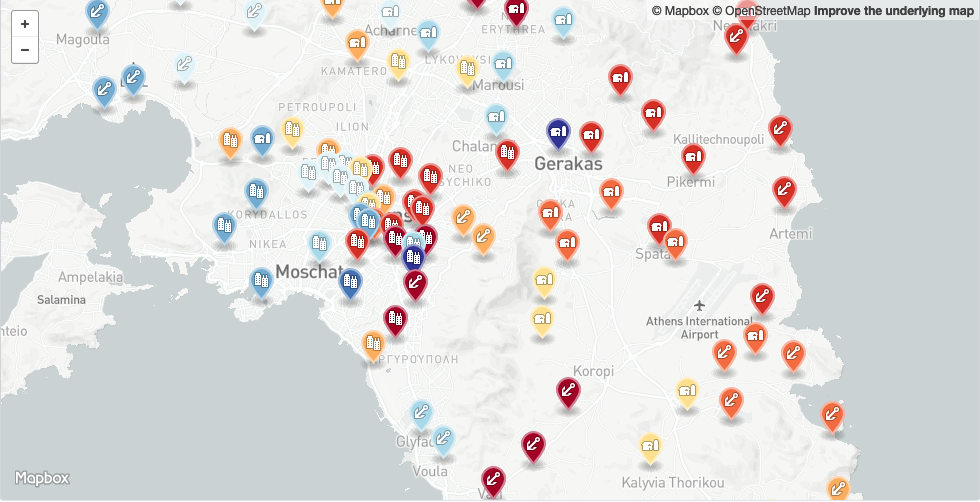Basic data on Attic Demes in TSV and GeoJSON, extracted from Traill (1975) and Whitehead (2014).
For governmental purposes Ancient Attica (Athens and the surounding area) was divided after 508 BCE into 10 "tribes" (φυλαί), 3 "thirds" (τριττύες) and 149 "demes" (δῆμοι). Each deme was assigned to one of the three thirds (city, coast, or inland) and one of the tribes. The assignments were made so that every tribe countained city, coastal, and inland demes. When juries were selected, for instance, 50 citizens were selected by lot from each tribe (for a total of 500 jurors) and the jury could be expected to contain a good mix of demes and trittyes.
Men's names were recorded in official inscriptions with patronymic (father's name) and a demotic (deme name). For instance, the Athenian general Thrasybulus would be recorded as Θρασύβουλος Λύκου Στειριεύς Thrasúboulos Lúkou Steirieús, "Thrasybulus son of Lykos of Steiria." Women were excluded from full citizenship in Athens and when women appear in inscriptions they are not named in this way.
- tribes-data.tsv: Names of tribes in tab-delimited format
- demes-data.tsv: Data on demes in tab-delimited format
- deme-data.geojson: Data on locatable demes in geojson format. Github renders this as a nice map (pictured above)
Tab-delimited basic data about the demes. The fields in the file are
| Name | Description |
|---|---|
| Name | Deme name in Greek |
| Transliteration | A consistent transliteration of the Greek |
| Anglicized | Anglicized version of the deme name. Essesntially whatever is found in Traill (1975) |
| Tribe | Number of the tribe to which the deme belonged. Numbers are traditional. For names see tribe-data.tsv |
| Trittys | The trittys to which the deme belonged. One of three values: city, coast, or inland |
| Bouleutaí | Number of councillors (bouleutaí) alloted to the deme. The number is estimated for the end of the 4th Century BCE, "but it is generally held that they had remained unchanged since being originally fixed by Kleisthenes" (Whitehead, D. [2014] 369). The numbers are from Whitehead (2014) 369-373, based on Traill (1975) "his own addenda in some instances." The number does not quite add up to 500 due to gaps in the record. Some demes had a variable number of bouleutaí in different years, alternating between 6 and and 7, which is recorded as 6.5 |
| Gomme | The number of known Athenians bearing a particular demotic included Traill (1975) from Gomme (1933). Where demes were later split into "upper" and "lower" demes, this count is divided over the two parts |
| Traill No. | Number assigned to the deme in the table in Traill (1975) |
| Pleiades ID | ID number of the deme in Pleiades (Bagnall, 2020) |
| Lat | Latitude of the deme from Pleiades (or Wikipedia where this seemed incorrect) if known |
| Lon | Longitude of the deme from Pleiades (or Wikipedia where this seemed incorrect) if known |
It's difficult to attach any meaning to Gomme's counts of known people from each deme--how much is only due to accidents of history?--but it is interesting to look at at which demes are "over-" or "underrepresented" if we take the number of bouleutaí as representing population. By far, more people are known from Akharnaí than anywhere else (452), but Akharnaí is also the 4th most underrepresented. With the most bouleutaí (22), Akharnaí accounted for 4.42% of the Council, but only 3.75% of the known people, a difference of -0.67%. Oîon Kerameikón is the most overrepresented (0.20% of the Council, 1.16% of the known people, +0.96%)
Data extracted from demes-data.tsv and reformatted as GeoJSON. Demes that have not been located are excluded. Github turns this into a nice map. Includes fields from tribes-data.tsv as well
Names and tradition numbers of the Kleisthenic tribes. The fields are:
| Name | Description |
|---|---|
| Number | Traditional number of the tribe |
| Name | Tribe name in Greek |
| Transliteration | A consistent transliteration of the Greek |
| Anglicized | Anglicized version of the tribe name. Essesntially whatever is found in Traill (1975) |
Gomme, A. W. (1933). The Population of Athens in the Fifth and Fourth Centuries B.C. Oxford: Blackwell, 1933.
Traill, J. (1975). The Political Organization of Attica: A Study of the Demes, Trittyes, and Phylai, and Their Representation in the Athenian Council. Hesperia Supplements, 14. Princeton: American School of Classical Studies at Athens. doi:10.2307/1353928
Whitehead, D. (2014). The Demes of Attica, 508/7 -ca. 250 B.C.: A Political and Social Study. (Course Book ed.). Princeton: Princeton University Press. muse.jhu.edu/book/35131.
Roger Bagnall, et al., eds. (2020). Pleiades: A Gazetteer of Past Places, http://pleiades.stoa.org/
